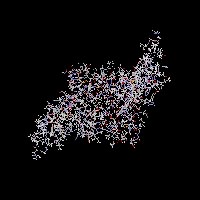Prior Knowledge:To Review.....
Cystic fibrosis is the most common fatal genetic disease in the United States today. CF causes the body to produce a thick, sticky mucus that clogs the lungs, leading to infection.
The affected protein is CFTR (cystic fibrosis transmembrane conductance regulator). The tertiary structure of CFTR consists of four domains: two are membrane binding and two ATP-binding.
An Artist's Rendering of the CFTR Protein:
Protein Family: ATP-Binding Cassette (ABC) superfamily, sub-family C, member 5
accession # AAB71758
Entrez Gene Link
Domains: 1. Highly conserved ATP binding cassette (ABC)
2. Less conserved Transmembrane domain
CFTR functions as a dimer and therefore constitutes four domains, two ABC modules and two transmembrane domains.
ABC transporters are involved in the export or import of a wide variety of substrates ranging from small ions to macromolecules. CFTR faciliates the movement of chlorine ions.
(Expasy-ScanProsite Tool) http://us.expasy.org/cgi-bin/nicedoc.pl?PDOC00185
To Summarize...CFTR Contains Five Structural Domains:
Two hydrophilic Nucleotide binding domains (NBD1 and NBD2)
Two hydrophobic Transmembrane domains
One Regulatory domain (R)
(CDD @ NCBI) http://www.ncbi.nlm.nih.gov/Structure/cdd/wrpsb.cgi?INPUT_TYPE=precalc&SEQUENCE=5685864
Nucleotide Binding Domain 1
· Spans 157 amino acids
· Includes Walker A
· Includes Walker B
· Includes A linkerA C
· Seven alpha helices
· Seven beta sheet regions
Picture of the Phosphorylated CFTR ND1 with ATP
Nucleotide Binding Domain 2
· High amount of homology with NBD1
· Includes Walker A region
· Includes Walker B region
· Includes A linkerA region C
· Predicted to contain seven alpha helices
· As well as, seven beta sheet regions
PDB SUM @ EBI
Secondary Structure Transmembrane Domains
-Hydrophobic region of CFTR
-Forms a channel for Cl- movement through the cell
-Can regulate Cl- by altering pore size. Many mutations occur in these domains which can lead to a decrease in ion selectivity
Primary Structural Analysis of CFTR
ProtoParam @ Expasy to determine Physical and Chemical Parameters for a given protein:
Computed parameters include the molecular weight, theoretical pI, amino acid composition, atomic composition, extinction coefficient, estimated half-life, instability index, aliphatic index and grand average of hydropathicity (GRAVY).
Computed Parameters of inputed amino acid sequence for CFTR, Homo Sapiens:
Number of amino acids: 1436
Molecular weight: 160856.6
Total number of negatively charged residues (Asp + Glu): 151
Total number of positively charged residues (Arg + Lys): 164
Atomic composition: Carbon C 7228Hydrogen H 11538Nitrogen N 1954Oxygen O 2068Sulfur S 61
Formula: C7228H11538N1954O2068S61
Total number of atoms: 22849
http://us.expasy.org/cgi-bin/protparam
Homologous Proteins?
CDART: Conserved Domain Architecture Retrieval Tool
CDART Results
Gene Ontology of CFTR @ the Gene Ontology Consortium
Cellular Component- integral to plasma membrane
Biological Process- transport
Molecular Function- ATP binding












 metal binding domain
metal binding domain
















